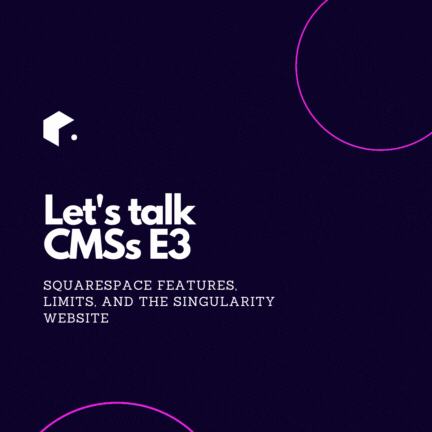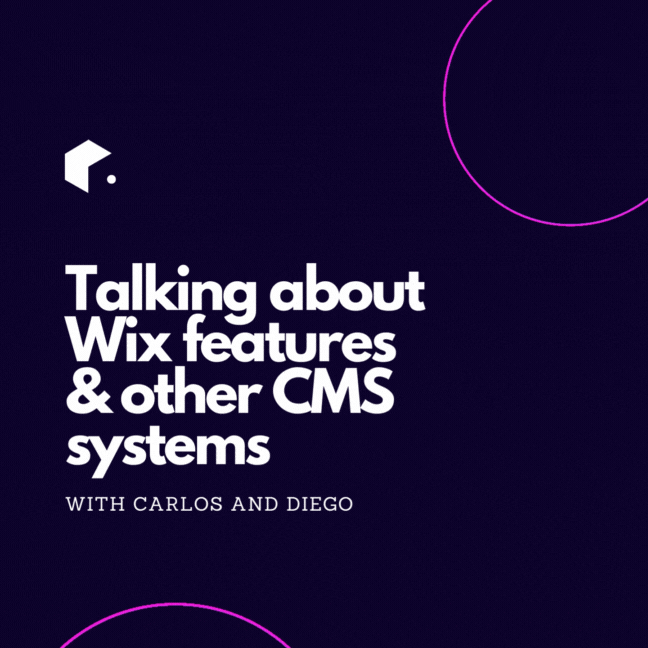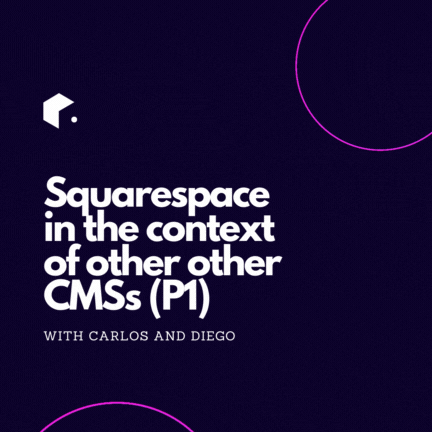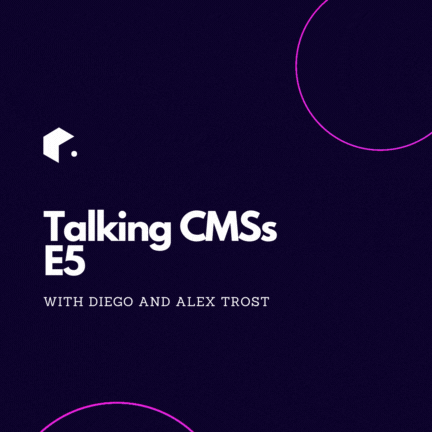-1.gif)
Let's talk CMSs E1 CMS: Comparisons Around Easiness of Use
Episode transcription
[00:00:00] Diego: So, welcome, Carlos, to this podcast. We are going to talk...
[00:00:13] Carlos: Thanks you.
[00:00:13] Diego: ... about a comparison.... You're welcome. We're going to be talking about a comparison on different CMSs that are available for businesses or for overall marketing users. And around that topic, I'd like to get started with an introduction to CMS systems. So as to let our audience know what exactly a CMS system is. I don't know whether you would like to get started with that part, answering: What is a CMS system? And why will a business need one?
[00:00:52] Carlos: Okay. So, a CMS or a content management system is a platform online that allows you to manage the content of a web app, of a website, of a mobile app even. And those are very helpful, especially for our marketing teams, to create new pages, to edit the content of those pages that they have on their website without using, or without needing a programmer, without actually needing someone that has knowledge in coding. They can easily manage that content or make changes, edit stuff, remove stuff from the website, etc. And yeah, those are, as I mentioned, really helpful for marketing teams on different businesses , to create websites, to manage the content of them, and to, again, edit them, add new images, add new copy, remove, edit, etc.
[00:02:03] Diego: Exactly, and this being answered, what we're going to do next is to compare different CMSs that are available on the market. That we are familiar with, by the way, because there' are hundreds, if not thousands, of CMS applications. And I believe that we can do that comparison around the following topics: ease of use, the features, and also, very important, the pricing. This being said, I believe that we can probably get served with separating CMS systems for e-commerce, and CMS systems for other types of websites that are not...
[00:02:57] Carlos: Or web apps, yes.
[00:02:58] Diego: Absolutely, based around e commerce. Oh! Also we can consider this third one: web apps.
[00:03:05] Carlos: Yeah.
[00:03:06] Diego: Yeah. So, maybe we can get started with the most common type of CMS system, the one that is not everything around e-commerce.
[00:03:18] Carlos: Yeah, for regular websites, like company, informational websites or, yeah, regular company websites, business websites. Yeah, there are a few... not a few, there are many CMS platforms! Either Headless or not. Headless are the ones that are pretty flexible and maneuverable for people to integrate with their own custom websites that are hosted on their own servers and everything that, and there are others that are attached to a specific platform like Wix or Webflow, for example. Framer is a new one that is also a website builder and a CMS, has CMS integrated with it; but in general, those CMSs are very helpful, and it really depends on the needs of the customer, or the needs of the person that is going to use it. Depending if there's a small business, depending on if they want to scale up the website, if it has any custom functionalities that are not simple to create or to integrate with a platform like either Wix or Webflow, maybe they will need something more versatile, more flexible for their programmer to integrate with. And, yeah, I guess there's a vast variety of CMS platforms for these kinds of businesses, or these kind of websites or informational ones. And it really depends on, again, of the size of the website, the needs of the client, and what else? To know what... which one is going to be chosen for that.
[00:05:30] Diego: I agree with that. I believe that there might be several ways of classifying that easy of use, perfect? . I was thinking about, maybe there are websites that can be classified into those three groups. In terms of ease of use for the person or team who is going to be creating. Notice creating, not only editing, but creating the overall website. I can think about DIY CMS systems, that would be surface system that allows a person with zero technical knowledge to build up and maintain a website, like for instance, there's Wix and there's one that we very recently used for free website for a movie at Squarespace, and also there's Weebly, there are many, Weebly. So, I believe this first type of website is very easy to use for a user or groups of users that are not only managing content, but creating the overall website. Those types of CMS allows them to create without any knowledge. I believe that in that regard, there is another group that will be for custom websites; I will call them that way, not very much based on templates, like Webflow, perhaps...
[00:07:19] Carlos: But these platforms... sorry to interrupt... but these platforms so also are integrating, or they also integrate stills like templates, or they have some kind of template store to get those sections or, those again, templates of a website for people to easily add content to them, and personalize them, customize them. So, yeah, those are very easy to use as well; even if you don't have much technical knowledge, there's a learning curve that it's not that it doesn't take too long to learn how to use these platforms. For example, Webflow, if you have a template and you don't have much technical knowledge you pretty much know how to make a few changes here and there in content to personalize, to customize your website.
[00:08:19] Diego: That is very true. So, maybe instead of, I'll change the second category in terms of ease of use to something like in... like for the signers slash developers, perhaps.
[00:08:35] Carlos: Yeah.
[00:08:35] Diego: Like the first category is more for, you're a business owner, you don't know, and you didn't have time to learn anything about how to create websites, just need to get there and get a website published fast...
[00:08:51] Carlos: In a short amount of time, you... yeah.
[00:08:53] Diego: You don't have time to learn anything. Now, this second category in which we were talking about Webflow I believe that's more for designers, slash developers, maybe...
[00:09:05] Carlos: You have a lot of options in that regard to build your website and to customize it as much as you want.
[00:09:14] Diego: Exactly, I believe that Webflow fills pretty well this category for designers; actually that is a target market of them. Designers like if you can do it in Photoshop, if you can do it in an XD, or Figma, then you can do it on Webflow, that's what they sell here.
[00:09:35] Carlos: They even have a Figma plugin to create your designs on Figma and then export and move them to your Webflowproject. So, yeah, that's, I will say, yeah, the, their target of, those platforms will be designers slash developers.
[00:09:52] Diego: Yes. And at a visual level, the difference between the DIY category and this designer category is that there's a lot more flexibility when it comes to how websites will look. Now, I think about Webflow here, and I was about to place HubSpot, WordPress within the same group, but I don't know if I create another group like it's more for developers. I'm not that sure about it.
[00:10:31] Carlos: Oh! Wow! That's interesting because... those have templates as well available to them, and the easiest views can be, again, pretty simple if you just choose a template and start adding content to start editing content based on those templates or... Considering the limitations that they have, considering that you have like a reduced sandbox to explore whenever you choose a template, but it's still it's there's a small learning curve. It's very simple to... Okay, this is the template that I chose, this is the content that I have and I start populating the website with my assets from my brand: logos, colors, copy and else imagery. So, that's, yeah, that's some kind of middle of the park kind of thing. It's an in between somehow because those can be powerful tools for developers to create something pretty custom, but also they can be very helpful if you just are a business owner, you want a website, you don't have the time to... or something you don't have the resources either, you're starting and you want to optimize your resources as much as you can, so you just want to do yourself, and you select the template and start populating the website with your content, and... that's I guess it's very simple to do in those platforms as well; but at the same time it allows developers create something bigger, something more complex and custom if they decide to do so... Yeah, I don't know how we'll label those specific...
[00:12:29] Diego: Yeah, I don't know either. I believe that instead of having subcategories, I will have a sort of line that will start with DIY at one side that will go down to designer. Then to developer and then to very much developer with outlet or something like that.
[00:12:52] Carlos: Yeah, the developer and that plus.
[00:12:54] Diego: And within that line I will place WordPress and HubSpot, like in between designers and developers because I believe that those are touching bases for both type of professionals. I'll have WordPress and HubSpot here. Okay. What else do we have within this developer and designer part of the line in terms of ease of use for creating the overall website? Because there is ease of use just for the marketer to manage content, and I believe that is to be traded differently.
[00:13:42] Carlos: Yeah, it's completely different if you are, for example, Headless CMSs or website builders, Headless website builders like Prismic, for example. I guess the ease of use for marketers or people that are going to be editing the content, or managing the content of the website, it really depends on how the developer sets it up. With Headless CMSs, Headless website builders, it there's a huge role, in terms of the person that sets up the CMS and how everything is structured, and how everything is presented to the people that are going to manage the content of the website. That is going to determine how easy to use or not a website is because you can have a platform that is very user-friendly, but if your developer set it up in a way that is very convoluted and complicated to understand, then you're not really taking advantage of the platform, and you're making things difficult for the people that are going to be managing the content.
And I guess that's a little bit of, a little bit of relative in regards to for some people it depends of the people that are going to manage the content because for some people a certain way of doing things could be like the most intuitive in their heads, it completely makes sense to them. But for others that can be okay, I don't really get this. Why are we doing this way when we could be doing it a different way that it could be simpler?
So, I guess it has to do with familiarity with the platform as well the ease of use in that regard, but specifically in terms of ease of use and the learning curve that you as a marketer are going to have, it really depends, for headless specifically, it depends on who sets it up more than with the platform, because the platforms are usually very similar in regards to what they offer and the flexibility that they have for developers to set up the CMS, but it depends on how the developer takes advantage of these features and these options and flexibility of the CMS to set it up and make it as user friendly as possible and intuitive as possible.
And in regards to... what you just mentioned about separating somehow what it is to how difficult it is something to for us, for a developer versus a marketer or the people that the team of marketing... the marketing team that works on editing the content of the website, or managing the content of the website.
In the case of Headless, it's something like... probably... there's some kind of... it's some kind of a mirror to go on somehow. It's like as long for a developer it could be more difficult. And it gets more difficult because it's completely custom and you have to be thinking all the time about the needs of your customer and put yourself in the shoes of the people that are going to be editing the content. So, that you get harder as you go by as time goes by and you're working on this project, and at the end of the day, if you as a developer give it much more thought and you work hard and try your best to optimize as much as possible the way you set up the CMS, the easier it's going to be for the marketing people to edit that content. At least that's, the expected result that if you give it much thought and if you put yourself in the shoes of the people that are going to be editing the content. Then, even if you spend a few extra hours or a few extra time thinking about it and try to optimize it as much as possible, the end result is that your customer is going to save a lot of time and resources because it's going to be more intuitive and easier to build pages, to edit content on the website, to add new content and new pages, etc. So, this thing some kind of inverse proportions over there like, in regard it went Headless... it hardly gets for developers to set it up, or not necessarily harder, but maybe you need more expertise, more knowledge as a developer to set up something like that, more experience and for the customers or for the people that are going to be working or editing the content of the website, it's going to get easier as long as there's more expertise that there's more, it's... there's more thought into that from the developers, and I want that so. That's, I guess, the separation that I will make with developers because with the same, the first category, which you will call it DIY, it's the same person that's the developer, and it's the designer, the developer, the person that edits the content and publishes the website and everything. But as long as you start separating that between the personas that are working on the website to build it or maintain it, versus the people that are just managing the content... that... I don't know; the further they go, or the further they separate, there's some kind of an, as I mentioned, an inverse proportions in regards to how easy it gets for one and for the other.
[00:19:59] Diego: I agree completely. This that you mentioned makes me think about an approach to talk about ease of use. That would be, that it depends on the project requirements because the more custom and creative functionality we have the less easy are the simpler platforms to use. So, DIY platforms will be either absolutely not usable or very difficult for everyone developers, designers, and content managers to use if we are having custom-crazy functionality. And I have an example, a very recent example with this: it will be this Squarespace website that we created for Apple TV movie or documentary that was developed using Squarespace, but it was very difficult for us to design, to code, and it will be in certain scenarios for the content managers to change things for that website in Squarespace, whereas a Headless or HubSpot approach will be... will have been much easier for us to create things and also for developers to create things. Or if you go to Squarespace to, that example that they have for the Super Bowl with Adam Driver, is an amazing website with very cool animation and any interactions on web... on web phone, sorry, on the Squarespace. But at the end of the day, it is all custom code, like in reality there is pretty much nothing that can be created using web phone native functionalities to replicate that kind of website. And also, that will be very difficult for account managers to change things on that Adam Driver website, the Singular website.
[00:22:05] Carlos: It's really interesting because, as you mentioned, that... there's something that... at the end of the day, there's a trade-off, all there's always a trade-off, and you're always trying to choose if you're in that position, if you want to make it simpler for the content managers to edit the content of the website, and create new pages, and maintain it, or if it's going to be... you know, that kind of... you know, awesome website with a lot of custom functionalities that are mind-blowing, but at the end of the day, behind the scenes, there's really not much that you can do without a programmer. And there's always that trade-off, and sometimes you have to either sacrifice design or functionality to try to make sure that there's like the most user-friendly experience for the people that are going to manage the content, or sometimes, you have to find some kind of balance. It's an interesting trade-off whenever you're using a platform that is going to have limiting features sometimes for a few sections. And it's actually very interesting because, at the moment, we say limiting, but they actually all these platforms, or most of them, allow you to use custom code on the website. And that makes you think, again, am I going to stay in this platform because I'm familiar with it, but I'm still... I'm familiar with something that if it's set up completely custom or there's a lot of custom code in it? Am I actually going to be doing anything using or any of the features that this platform provides us with? So, that's definitely an interesting thought to have whenever you're making some kind of decision for what CMS you're going to go for.
[00:24:06] Diego: Absolutely. So, just to summarize until this point, I believe that we are having, we can draw a line for easy of use ws on CMS systems, a line that will be a technical knowledge line that could start with DIY with CMS systems such as Wix, Squarespace, Weebly that moves towards designers or for designers with Webflow and then moves in between designers and developers for WordPress, HubSpot, and that we can kind of points towards Headless or very much for developers or even for teams developers.
[00:24:58] Carlos: That is, yeah, sometimes for teams of developers, yeah. And the interesting part that it's with the exception of Headless, most of these platforms, even the ones that are for designers or for developers, or for designers and developers they have this entry-level that is closer to the DIY that allows you to have, like, again, you pick up template, and you can start working on these platforms even if you don't have much technical knowledge. There's definitely, I guess, a bigger learning curve for those in comparison to the ones are in, as you mentioned, that DIY category, to call them somehow, but there's still those options; there's some entry levels that are closer to the DIY for those platforms, it's like the gateway to this platform, so you want to learn more about it, and you want to grow your knowledge in using either Webflow or HubSpot and stuff like that; there's still an entry-level to this in terms of the technical knowledge that you need to start working with them.
[00:26:01] Diego: Absolutely. And for Headless, which will be like the other part of the line that is very technically demanding, we will have CMS systems such as Prismic, Sanity...
[00:26:23] Carlos: Strapi.
[00:26:25] Diego: Strapi is another one. I mean, there are many contentful, etc. The ones we know are Strapi, Prismic, and Sanity. But, yeah, I believe that... So far, we have this DIY: Wix, Squarespace, Weebly. Then we're having designers with Webflow, slash developers with WordPress and HubSpot. WordPress is, by the way, kind of a do-it-all CMS system because there are plugins within WordPress that can allow WordPress to be used for designers, and there is also the possibility for developers to code a template. So we will be talking about...
[00:27:08] Carlos: Completely custom.
[00:27:09] Diego: ... developers rather. So that's why I'm placing something... placing WordPress like in between the designers and developers because there are options for both. There's HubSpot as well. I believe there the HubSpot can be placed in between the end of DIY because there haven't templates that people without any sort knowledge can use than developers. I don't think that will be much of a platform for designers, but it will be like jumping in between DIY with already created templates to developers with create your own and do whatever you want.
[00:27:50] Carlos: Yeah, I will agree. I completely agree with that.
[00:27:53] Diego: Yes. In terms of flexibility... but no, we're not touching ease of use here. I believe flexibility for the features part of the conversation, which I believe will be for the next... for an upcoming podcast, as well as talking about pricing. But anyways. No... there's e-commerce because we had talked about CMS systems for service times or websites.
[00:28:22] Carlos: Yeah, mostly informational websites. Mostly, the website where you explain or showcase the features, the benefits of your product, or service or business. And one pretty much are looking for people to contact you or to get a demo or something like that, but it's different in regards to an e-commerce website and in this case, there are platforms that are dedicated specifically to e-commerce.
[00:28:56] Diego: Yes, which is not to say that we can't do e-commerce with any of those platforms we already mentioned. For instance, Squarespace is very strong in e-commerce, as well as Wix is allowing a plethora of possibilities there. As well as Webley's also Webflow is aligned with...
[00:29:15] Carlos: It has a... couple of years now working with e-commerce.
[00:29:18] Diego: Exactly. WordPress via plugins is allowing functionality with e-commerce and all others. But we might be talking about websites that are very focused on e-commerce, so much so that if they use an e-commerce-centric platform there's pretty much nothing aside from e-commerce. So, I'm talking about Shopify and BigCommerce.
[00:29:55] Carlos: Yeah. Those are platforms that are specifically created for e-commerce websites like, as you mentioned, the main focus is to sell your products via those platforms. And it's very interesting because, again, if you want to have sometimes customized block, or completely custom experience explaining the features of your product or anything like that, that might not be that user-friendly. Shopify has apps like PageFly or Shogun that allows you to have some kind of website builder inside your Shopify website, or with the new, or relatively new, it's from, I believe, last year the Shopify, or templates themes, I'm sorry, themes 2. 0 which allows you to have more flexibility in terms of managing the content using some kind of drag and drop kind of interface that they already have, but they have been improving recently. They have metafields now, so that's improving, but it's not the main focu; again, the main focus and where they specialize is e-commerce and all that is very intuitive, very easy to work with. I'm talking about Shopify, but the same applies to BigCommerce in regards to whenever you're going through their interface of their CMS the main focus is e commerce. And it's very intuitive and easy to use whenever it comes to you managing the inventory, or managing the pricing and descriptions imagery and the way that you took your products to be sold. And also very important, again, for the people that have e-commerce websites, the reports, the data that they get in the information regarding the orders, how to fulfill them, if you are shipping, if there's our physical products whenever where you ship them, from the shipping rates and everything in that regard. It's again, its design; it's created to be easy to use in that regard, in regards of e commerce. Whenever you're moving away a little bit from that and want to do something more custom in the experience of the website, then you start getting, as you mentioned, like it gets harder, a little bit harder to create something or to manage the content of something in comparison with using another, other of these platforms. As you mentioned, so, that's definitely there is a why you separated the more informational like websites, the platforms are for this kind of more informational like websites, and the platforms are dedicated to e-commerce.
[00:33:00] Diego: Yes. And what's interesting to me is that I believe both Shopify and BigCommerce are targeting customers or users all across this line of technical knowledge because they're targeting people in the DIY section, even with the possibility of having an e-commerce without a website, like just with social media.
[00:33:31] Carlos: Yes.
[00:33:33] Diego: That's a very DIY functionality of Shopify. It's very targeted to that kind of... or that part is the technical knowledge line. But also, they allow people with the possibility of, without knowledge, get create and publish an e-commerce website with a template in the platform.
[00:33:57] Carlos: Yeah.
[00:33:58] Diego: But if you want a little bit more, they can allow designers to play around with the design of a store, either within Shopify or also via having the store in another platform, such as Webflow, and embedding a buy button from Shopify into that platform. But also, they can allow developers... we're moving, notice like we're moving from DIY to designers to developers they can also allow developers with the possibility to create a custom theme. And also, they have this possibility to allow developers to integrate Shopify with a Headless system.
[00:34:53] Carlos: Shopify Plus, they have their own Headless system.
[00:34:56] Diego: Exactly. So, notice how Shopify and BigCommerce are trying to cover all of the parts of this technical knowledge line, and they can integrate with other CMSs that are placed into different parts of this technical knowledge line. So, at the end of the day, I believe we can summarize things as follows: First, ease of use, which was our first thing to compare between CMS systems; depends on the project requirements because you can have various C functionalities, and then a DIY platform can cover you pretty well, or you can have very custom and crazy functionalities, or designs, like that example of the Adam Drive Singularity website, on which a DIY platform such as Squarespace will be very challenging for designers, for developers, and even for content managers. But we can talk about ease of use, like drawing this technical knowledge line in which we place platforms from DIY to designer, to for developers, to for very much developers in the Headless part of the line. And that is for CMS systems for managing content. Some of those can also do e-commerce, but there are also, platforms that are very focused on e-commerce, like BigCommerce or Shopify. And those two platforms cover all of the personas on that technical knowledge line. I would summarize that as that.
[00:36:57] Carlos: Yeah, I completely agree. And I believe these platforms, in general, their approach is what you just mentioned, at the end of the day, with e-commerce platforms, but I believe that most of the platforms are trying to do that, either if they're dedicated to e-commerce or not. They want to appeal to as much of the demographic, or... as many customers as possible, from the ones that have more technical knowledge to the ones that have little to non-technical knowledge. And they want to make it, yeah, accessible to anyone in that expector that you just mentioned. So, you have the range of technical knowledge, from people that know either nothing about programming or know very little, to people that are experts in that regard. And that's really interesting, and it's great from this platform to work like that, to give that flexibility to users, to visitors and this variety of options for them to create their own website with... that will satisfy the needs that they have or the requirements that they have for their business.
[00:38:15] Diego: Totally, totally. Well, just to wrap up this conversation, I'm going to mention a few things that I believe will be cool for us to cover on the future podcast within this series of CMS systems. We already talked about ease of use; I believe that we can talk next about features, pricing, support, maybe. And also, case studies like who this CMS is for, and maybe what are the key factors for you to consider choosing one CMS over the other.
[00:38:55] Carlos: Specific CMS over the other, yeah.
[00:38:58] Diego: So, I believe that we're having many podcasts to... on which to talk about this, yeah.
[00:39:04] Carlos: 100%.
[00:39:06] Diego: Perfect, thank you very much, Carlos, for joining me on this convesation.
[00:39:09] Carlos: Thank you for inviting me. Nice talking to you.
[00:39:12] Diego: Excellent. Well that's nice. Thank you. Bye bye.
[00:39:16] Carlos: Bye bye.
More to enjoy...




About the series
Join us for Tech Talk, a business podcast hosted by the Quo Agency, a leading provider of complex CMS integrations and website design and development services. Our expert guests and hosts dive into the latest technology trends, and industry news and share insights and strategies to help businesses succeed in the digital space. So whether you're a seasoned tech pro or just starting, Tech Talk is the podcast for you. Please tune in and find out about the latest in website development, CMS integrations, and more.
Key moments

Let's talk CMSs E3: Squarespace features, limits, and the Singularity website

Let's talk CMSs E4: Squarespace features in the context of other types of CMS systems

Let's talk CMSs E2: Wix features in the context of other types of CMS systems
-1.gif)




